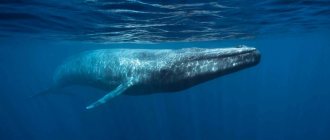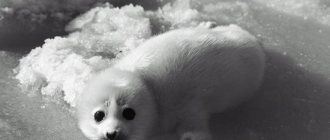Whales are one of the largest creatures on our planet. Their habitat and appearance, of course, make them resemble fish, but these are mammals. You probably know that genetically, the closest relatives of whales are hippos! Whales are actively used in mythology and heraldry. But do we know everything about these amazing creatures? The editors of TopCafe enjoyed studying the world of whales, and now we will take a closer look at the huge inhabitants of the World Ocean. Here are the most common types of whales.
1
bowhead whale
Scientific name: Balaena mysticetus Length: 14 – 18 m. Weight: up to 150 tons
The bowhead whale is better known as the "Polar" or "Arctic" whale. It is distinguished by its nose-like jaw structure and the absence of a dorsal fin. Moreover, their mouth is the largest of all whales.
The average lifespan of this mammal is 180 – 200 years. They live in cold arctic waters.
2
Northern right whale
Scientific name: Eubalaena glacialis Average length: 16 m. Weight: up to 80 tons
The low speed of movement (no more than 10 km/h), their habitat and friendliness played a cruel joke on right whales. These creatures have been the main target of whaling since the 11th century. Until now, their population is rapidly declining, despite the activities of volunteers from animal protection organizations. At the moment, there are no more than 400 individuals in the waters of the North Atlantic.
The lifespan of these animals is still controversial among scientists. According to various sources, it can range from 70 to 130 years.
3
Classification and evolution
The order Cetaceans includes:
- two living suborders - baleen whales (Mysticeti) and toothed whales (Odontoceti)
- one extinct suborder is the ancient whales (Archaeoceti).
Baleen and toothed whales are believed to be descendants of extinct ancient whales. There are at least 83 living species of cetaceans, consisting of 46 genera and 14 families. Of the two extant suborders, odontocetes are the larger and more diverse, containing at least 70 species, 40 genera, and 10 families. Cetaceans have evolved from land animals to fully aquatic life forms. Cetaceans live, breed, rest and perform all their vital functions in water.
Japanese whale
Scientific name: Eubalaena japonica Average length: 15 – 18 m. Weight: up to 100 tons
This is another species of whale that is currently in danger of extinction, only this time the main reason can be cited as pollution of the world's oceans and climate change. The habitat is limited to the Sea of Okhotsk and the coast of the Kuril Islands.
Since 2011, there has been a trend of species mixing (hybridization) - for the sake of survival, the North Pacific and North Atlantic right whales mate. However, these are isolated cases, because it is almost impossible to meet them in open water. The editors of TopCafe hope that in the near future the populations of all whales will return to normal.
4
Habitat
Cetaceans live in the waters of all the oceans of the planet, and some species live in freshwater lakes and river mouths.
Cetaceans also live in the seas. There are whales that prefer coastal areas, and some have chosen the waters of the open ocean. Killer whales can be found in any ocean on the globe. There are cetaceans that live in a certain hemisphere, for example, southern minke whales. There are animals that live only in the Pacific Ocean. You can find whales in estuaries and swamps.
Living conditions depend on the latitude of the ocean and the changing seasons of the year. Many species migrate.
Southern right whale
Scientific name: Eubalaena australis Average length: 15 m. Weight: up to 90 tons
This species of whale is quite numerous and predominantly inhabits the waters of the Southern Hemisphere. According to average estimates, their population exceeds 11,000 individuals. These creatures are quite fast, social, and not aggressive. They come so close to the coast that residents of Argentina can see them literally from the shore between June and December. An amazing fact: it is the southern right whales that most often give birth to white albino calves, and they are always boys.
Previously, this species, along with the Japanese species, as well as northern whales, were identified as one species due to their external similarity, but DNA tests showed that these are 3 different species.
5
Amphibious whales
One of the most significant discoveries of ancient cetaceans, the “missing link” in their evolution, was the ambulocetus natans
).
Its name, meaning "swimming walking whale", speaks for itself. An almost complete skeleton of this animal was found in northern Pakistan in sediments dating back to about 49 million years ago []. The appearance of the three-meter ambulocetus resembled a large-headed crocodile. When swimming, its body curved in a vertical plane, like those of modern whales, seals and otters. It is believed that ambulocetes hunted like crocodiles, lying in wait for their victims in shallow water (they could not actively move on land). Ambulocetes had powerful jaws and teeth and were capable of killing fairly large prey. The structure of the nose allowed the “amphibian whale” to swallow food directly in the water. The eyes provided only lateral vision. Ambulocetus apparently lost its auricles, but could hear well in water. He tracked the movement of his prey on land by pressing his head to the ground and catching vibrations of the substrate. Chemical analysis of the teeth showed that the animal could hunt in both saltwater and fresh water bodies. The ambulocetid family includes two more genera: Gandakasia
and
Himalayacetus
. The latter is notable for its antiquity, the largest among cetaceans - 53.5 million years.
Reconstruction of the appearance of Ambulocetus. Drawing by K. K. Tarasenko
Smaller relatives of ambulocetids were remingtonocetids, known from India and Pakistan, from sediments dating back 49–43 million years ago. These animals had highly elongated jaws and were somewhat better adapted for underwater swimming than ambulocetids. They also had well-developed limbs, but were distinguished by small eyes, thin jaws and an expanded skull base. If we compare “amphibious whales” in general appearance with crocodiles, then among them ambulocetids more closely resembled alligators, and remingtonocetids resembled gharials. The structure of the auditory area, combined with small eyes, indicates that remingtonocetids relied primarily on hearing to detect prey. Six genera of remingtonocetids are known. Their sizes were small: for example, Kutchicetus minimus
) did not exceed the size of a river otter.
For Andrewsiphius sloani
, the presence of a powerful flattened tail has been established, which served as the main organ of movement in the aquatic environment [].
Rayanistes afer
, found in the Middle Eocene of Egypt [], demonstrates that remingtonocetids reached the southern coast of Tethys.
Blue/blue whale
Scientific name: Balaenoptera musculus Length: 29 – 33 m. Weight: up to 170 tons
The blue whale is a giant among all cetaceans! He still remains the largest creature that has ever lived on our planet. His tongue alone can weigh up to 3 tons! We wrote about it on the pages of TopCafe in an article about 10 endangered animals that can still be saved.
In individuals of this species, only the sense of touch and hearing are well developed, but other senses are atrophied.
It is interesting that the teeth of these whales are replaced with mustaches. Baleen is a natural filter element through which water and all organisms ingested by the creature pass. Every day the blue whale eats up to 2.5 tons of plankton.
Whales reproduce very slowly. The female gives birth to offspring once every 3–4 years; the gestation period can reach 1 year.
6
Humpback whale
Scientific name: Megaptera novaeangliae Length: up to 18 m. Weight: up to 30 tons
Humpback whales are easily recognized by their long pectoral fin and massive body. As the only member of the genus Megaptera, humpback whales have other distinctive bodily qualities.
These animals are very popular among whale watchers because of their explosive behavior on the surface (spy jumping, tail flapping, singing). Their diet consists of plankton and some types of schooling fish.
They are true romantics at heart! During the mating season, males perform “serenades” with a frequency of 5,000 Hz. TopCafe gives you a unique chance to listen to the sounds these animals make.
7
Founders of the dynasty
Ancient cetaceans evolved quickly, and the transition from semi-terrestrial forms to permanent aquatic forms took approximately 8 million years. The primitive Eocene cetaceans, called archaeocetes (ancient whales), are divided into five families - pakicetids, ambulocetids, remingtonocetids, protocetids and basilosaurids. In 2001, the first anatomically complete skeletons of archaeocetes became known, which made it possible to elucidate in detail the process of transition of cetaceans to life in the sea [].
Pakicetids lived in the early Eocene (about 52 million years ago) on the northern coast of the subtropical inland Tethys Sea, which at that time crossed Eurasia in a latitudinal direction. These were large-headed and long-muzzled animals with hooves on their fingers and long tails, the pakicetus and nalacetus ( Nalacetus ratimitus
) in size corresponded to a wolf, and the ichthyolestes (
Ichthyolestes pinfoldi
) corresponded to a fox. Judging by the structure of the skeleton, pakicetids swam well, using wave-like movements of the body and strokes of the limbs. In terms of the structure of the auditory region of the skull, they are similar to whales. However, the ears of pakicetids were adapted to perceive sounds in the air, rather than in the aquatic environment. Consequently, these animals lived on land, foraging in and around shallow freshwater bodies, much like modern tapirs. Skeletons of pakicetids have been found in Pakistan and Northwestern India, in river sediments. Apparently, these places were the center of origin of cetaceans.
Data on the evolution of the system of semicircular canals of the inner ear, involved in the regulation of balance and body position in space and responsible for the control of locomotion, indicate that pakicetids in this regard were still close to terrestrial mammals [].
Gray whale
Scientific name: Eschrichtius robustus Length: up to 12 – 16 m. Weight: up to 30 tons
The gray or gray whale is the only extant species of the genus Eschrichtius. As their name suggests, gray whales are dark gray in color and have many white spots throughout their bodies.
Instead of a dorsal fin, gray whales have a slightly raised midline known as a dorsal crest. Gray whale populations are located in two corners of the world; the eastern North Pacific and the western North Pacific.
In 2015, a gray whale crossed the Pacific Ocean, covering a record distance of more than 22,000 km.
Gray whales are listed in the Red Book of Russia, but they are hunted in a limited manner in Chukotka (the number of individuals for annual slaughter and the types of weapons used are limited).
8
Cetaceans
Cetaceans are mammals that are well adapted to the aquatic environment and never leave it. Life in the water has given them a characteristic “fish-like” appearance: the body has acquired a streamlined shape and ends with a powerful caudal fin, deployed in a horizontal plane, and a number of cetaceans also have a dorsal fin. The hind limbs disappeared, and the front limbs turned into flippers. But, like all mammals, cetaceans are warm-blooded, breathe air and feed their young with milk.
They have a large and very complex brain and are at a high stage of evolution. Cetaceans have lost their hair; the function of thermal insulation is performed by a thick layer of subcutaneous fat. Their nostrils (blowholes) have moved to the top of their heads and are closed with valves while diving. These animals are capable of not breathing for a long time, remaining under water for up to 30-40 minutes or even longer. Their lungs are resilient and elastic, capable of rapid compression and expansion, and significant amounts of oxygen can accumulate in their muscles. When emerging, the whales inhale and exhale, and a fountain of steam rises into the air, varying in shape and height among different species.
Blue whale
All cetaceans are divided into two large groups - baleen and toothed whales. The blue whale, humpback whale, sei whale, gray whale, bowhead whale and other giants of the seas are baleen whales . Most of them feed on krill and other planktonic organisms and small fish. They have no teeth, but a thick fringe of flexible horny plates (whalebone) . There can be from 130 to 400 such plates in different species, and they vary in length. Swimming into a concentration of krill, the whale takes a mouthful of water, then closes its mouth and squeezes the water out with its huge tongue. The food remaining in the mouth is swallowed.
Whalebone
In order not to choke, the cetacean baby is born tail first, and the mother or other members of the herd help it float to the surface to take its first breath.
Baleen whales
Minke whales , or minke whales , are a family of baleen whales. They got their name because from 12 to 120 longitudinal folds of skin run from the bottom in the front of their body. Perhaps these folds direct water flows along the whale’s body, making swimming easier, and also, by stretching, increase the volume of the oral cavity, which is important when catching prey. The body of minke whales is slender, elongated, and they are all good swimmers.
Minke whale
This family also includes small whales, such as the minke whale , the size of a killer whale, and the largest animal on Earth - the blue whale , or vomit . Its length reaches 32 m, and its mass is 150 tons. One tongue of a blue whale weighs 3–4 tons, and its mouth is the size of a room with an area of 24 m2. Blue whales live alone or in small groups of 2-3 individuals. They are found in the open seas from the Arctic to Antarctica, preferring cold waters rich in krill (their main food), and only with the approach of winter, having accumulated a fair amount of fat, do they migrate to warmer areas. Once every three years, the female brings a cub weighing 2-3 tons. Feeding on mother’s milk, it gains approximately 100 kg in weight every day. Currently, there are only about 10 thousand blue whales left in the world.
Fin whale
The fin whale , or herring whale , is the most elegant and fastest whale of the minke whale family, second only in size to the blue whale. The second name of the whale - herring - is due to the fact that its diet includes small schooling fish, such as herring. The fin whale filters its prey through a whalebone sieve. These whales stay in groups away from the coast. In areas with an abundance of zooplankton they form large aggregations. Their numbers have decreased due to intensive fishing.
The fin whale swims into a school of fish on its right side, and even its jaws are colored asymmetrically: the right one is white, the left one is black. Whales hunt together, surrounding their prey on all sides.
The low dorsal fin of the humpback whale , or humpback, resembles a hump, which is why the whale got its name. Its pectoral fins are the longest among cetaceans (up to 6 m) and make up up to a third of the body length; there are 2-4 stripes on the belly. Humpback whales are considered the most active baleen whales. They are able to jump out of the water and even do somersaults over their heads, and then fall into the water with a loud splash. Humpback whales live in coastal areas and are also found in the open sea. They feed on schooling small fish and crustaceans. They spend the summer in cold polar regions, and by winter they migrate to tropical waters.
Smooth and gray
Polar whale
right whale family includes baleen whales without skin folds on the belly. Their body is less slender than that of minke whales, and almost a third of its length falls on the head with a huge wide mouth. Their remarkable representative is the bowhead or polar whale . In full accordance with the name, these whales live in the Arctic and subarctic regions, in Russia - mainly in the Bering and Chukchi seas. They often stay in open waters, perfectly navigating among floating ice even in the polar night with the help of echolocation. Bowhead whales are capable of punching a hole in ice 20-30 cm thick, but sometimes they find themselves trapped in the ice. The bowhead whale has the longest baleen plates, reaching 4.6 m. About 300 such plates hang from each side of the jaw. They form a fine sieve, allowing the whale to feed on the smallest crustaceans.
Southern whale
The Japanese or southern right whale spends the winter in temperate waters and migrates to the Arctic seas in winter. Japanese whales in the 1840s. were a convenient target for fishing: they are quite slow, cannot stay under water for a long time, and feed near the surface. As a result, over the course of 25–30 years, almost all of them were eliminated and are now in danger of complete extinction.
In the recent past, baleen plates from right whales were in great demand - in the absence of plastic and other synthetic materials, they were valued for their strength and elasticity.
Gray whale
The only representative of the gray whale family is the gray whale . This whale has retained some of the features of its ancestors - land vertebrates. For example, he, unlike other whales, can turn his head slightly. The gray whale is distinguished by the fact that it feeds not on plankton, but on crustaceans, worms, mollusks and other bottom organisms, stirring up silt with its snout and filtering it through hard, short and sparsely spaced baleen plates. Gray whales dive to a depth of 50 m to feed. When diving, the gray whale goes down almost vertically, so tail blades always appear on the surface of the water. Gray whales of the Chukotka-California population make the longest migrations of all mammals, swimming up to 20 thousand km annually. In the summer they feed in the Chukchi Sea, and for the winter they go to the shores of California.
The most famous toothed whales
The largest whales among the toothed whales are sperm whales . The length of the largest males reaches 15 m, weight - 45 tons, female sperm whales are almost twice as small. About 1/4-1/3 of the length of these whales comes from a huge head, shaped like a suitcase. In its front part there is an organ filled with a fat-like substance - spermaceti. Its purpose is not entirely clear; perhaps it plays an important role during diving. The sperm whale's very narrow lower jaw has 50 pairs of massive conical teeth.
For many years, sperm whales were objects of whaling. They were mined for spermaceti, which was widely used in the cosmetics industry and as a lubricant in technology.
Sperm whale Sperm
whales live in warm and temperate waters; with the onset of cold weather, they make seasonal migrations, going to warmer waters. Males move much more widely than females. The main food of sperm whales are squids, including giant ones. For this prey, sperm whales dive to depths of more than 1 km, and indirect signs suggest that they are capable of reaching a depth of 3 km. In any case, this is an absolute record for air-breathing animals. At such depths, vision is powerless, and sperm whales hunt using echolocation. They can remain underwater for more than 2 hours, although they usually surface much more often to take a breath. Usually these whales live in herds consisting of 10-15 females and a male. Mutual assistance is developed among the herd: whales will not leave a wounded or sick relative in trouble, they will help him stay on the water and protect him from attack.
killer whale
The killer whale is the largest representative of dolphins and the only true predator among cetaceans. Wandering widely across the seas, they are found in the seas of the Arctic Ocean and in the Antarctic seas. It is no coincidence that killer whales are called whale killers. They are capable of attacking fish of any size, and some of them specialize in hunting seals, baby whales and penguins. The length of the killer whale reaches 10 m, weight - 8 tons, the height of the dorsal fin - 1.8 m. Most marine inhabitants are unable to escape from the killer whale, since it reaches speeds of up to 55 km/h and is one of the fastest swimmers. These predators live in herds, which include about 30 individuals of different sexes and ages. Most of the whales included in such a pod have family ties: killer whale calves, growing up, remain with their mothers. Such a flock hunts together. There are known cases when killer whales overturned ice floes with penguins located there and caught them in the water.
Voices of whales
Sounds travel faster and further in water than in air. Therefore, cetaceans, which have practically lost their sense of smell, have excellent hearing. Ears are not needed in water, but the inner ear of these animals is capable of detecting even ultrasound and infrasound that are beyond human audibility. Cetaceans are social animals, and sounds play a huge role in their communication. Even baleen whales, which are considered the most silent, are capable of producing a variety of sounds using a powerful throat sac connected to the larynx. In particular, humpback whales perform a kind of choral “singing” while moving, including creaks, trills, howls, and squeaks. And during the mating season, male humpback whales perform solo numbers. Their singing is more varied than the singing of birds, and low sounds spread through the water column for several kilometers. With age, males improve in their skills.
Humpback whale
Many species of toothed whales and some of the baleen whales have a perfect echolocator , allowing them to navigate in the aquatic environment using sound signals and surpassing in its capabilities anything created by man. Animals emit specific location sounds and then pick up the reflected echo from various underwater objects. The main role in the sonar transmission mechanism is played by air sacs, which are concentrated in the soft tissues of the head above the bony nostrils. The fat pad and the concave surface of the skull focus the emitted signals and direct them into space in the form of a beam. Acoustic waves reflected from objects travel to the lower part of the jaw, and then into the ear. Dolphins constantly shake their heads, scanning the space as they approach the object being located.
Whales and man
The history of the relationship between man and whale is very long. Already in ancient times, people went to sea in boats and hunted whales for meat and fat using harpoons. But such hunting did not cause much damage to the number of whales. The situation changed dramatically in the Middle Ages, when Europeans began to build seagoing ships. They immediately began to be used for whaling . The objectives of the fishery have also changed. Now only the subcutaneous layer of fat (blub) and whalebone were removed from the killed whale, and the huge carcasses were thrown into the sea. When sailing ships were replaced by motor ships, and harpoon cannons began to be used instead of primitive harpoons, the dangerous hunt for sea giants turned into routine murder.
By the end of the 19th century. Only a tiny fraction of the once huge populations of large whale species remain in the fishing areas. The Atlantic gray whale population was especially affected, as it feeds in coastal waters and is leisurely, and most importantly, its carcasses did not sink into the sea. Minke whales, a family that includes the largest and fastest species (blue whales, sei whales, fin whales, etc.), were significantly less affected. What saved them was that, firstly, they are very careful, swim very quickly, and most importantly, they drown due to a small layer of subcutaneous fat. The peak of whale killing occurred at the beginning of the 20th century, when floating whaling factories appeared, where up to 100 individuals could be processed per day. It can be argued that the massacre that began has no equal in the history of human-animal relationships.
Whale and tourists
In 1946, the International Whaling Commission (IWC) . She established restrictions on the hunting of whales and prohibited the hunting of females with calves and young animals. In 1982, the English researcher N. Mackintosh calculated that in Antarctica, the “stocks” of fin whales decreased by 5 times, blue whales by 25 times, and humpback whales by 30 times. Nowadays, whale hunting is allowed with great restrictions. Thus, in Russia, about 130 whales are allowed to be caught only by the indigenous residents of Chukotka. But the number of whales is also declining for other reasons: humans are destroying the whales’ food supply (herring, capelin) and polluting the ocean. But, for example, Japan, having formally joined the ban on industrial whaling, left itself a loophole in the form of “capturing whales for scientific purposes.” The meat of hundreds of whales, purportedly poached for study, is being supplied to Japanese restaurants.
On February 19, 1986, the IWC banned industrial whaling and the sale of whale meat worldwide. On this day, environmentalists and marine mammal defenders celebrate World Whale Day.
Hector's dolphin
Scientific name: Cephalorhynchus hectori Length: up to 1.4 m. Weight: 40 – 60 kg.
Hector's dolphin is one of the smallest and rarest species of cetacean dolphin on Earth. Until now, nothing is known about their social hierarchy, level of intelligence development and methods of communication.
This species was first described in 1881 by a scientist from Belgium. Hector's dolphin is endemic to New Zealand, and received its name from the Wellington Museum employee who discovered this species.
9
Killer sperm whales and Leviathan himself
In the early Miocene, about 20 million years ago, sperm whales (Physeteroidea) appeared. Nowadays they are specialized squid hunters. However, some Neogene sperm whales were the killer whales of their time, occupying the ecological niche of killer whales until their appearance about 3 million years ago. The name "killer sperm whale" in the scientific literature was given to Zygophyseter varolai
) from the Late Miocene of Italy, 10–7 million years ago [].
This whale was 6–7 m long, with a powerful skull and numerous large teeth in the upper and lower jaws. Other killer sperm whales were also formidable predators: the seven-meter-long Brygmophyseter shigensis
from Japan (age 15–14 million years ago) and representatives of the genus Acrophyseter
from
Peru (9–6 million years ago), reaching only 4 m in length, but also occupied the niche of active sea hunters [].
Remains of a much larger marine predator were also discovered in Peru, dating back 10–9 million years ago [, ]. The giant killer sperm whale reached 18 m in length and weighed about 40 tons (about the same as the males of a modern sperm whale). The length of its skull is about 3 m, and its teeth have a diameter of about 12 cm and a length of up to 36 cm. Perhaps these are the largest teeth in the animal world, not counting hypertrophied fangs and tusks. The colossus was called "Melville's Leviathan" ( Livyatan melvillei
), in honor of the biblical monster Leviathan and the American writer Herman Melville, author of the novel “Moby Dick, or the White Whale”. It can be assumed that the appearance of such large predators was associated with the development of gigantism among their potential victims - baleen whales.
Short-finned pilot whale
Scientific name: Globicephala macrorhynchus Length: about 5.5 m Weight: about 3 tons
Due to their small distribution, short-finned pilot whales are still very little studied. They have a small jaw and short, rounded fins. The color is gray-blue with numerous white spots or scars throughout the body. The shape of the dorsal fin can differ from one individual to another, as it is determined by age and sexual orientation (Yes, this occurs among whales).
10
killer whale
Scientific name: Orcinus orca Length: 6 – 8 m. Weight: about 6 tons
Killer whales are one of the best predators in the world's oceans. They easily hunt tiger and white sharks, and even larger whales, including sperm whales and gray whales. A complex social hierarchy and high intelligence help them become brilliant hunters.
There are no cases of killer whales attacking humans in open water. However, in captivity (aquariums), these creatures drowned trainers, but did not eat them. Hence the conclusion: killer whales do not consider people as food.
11
Pygmy killer whale
Scientific name: Feresa attenuata Length: about 2 m. Weight: about 170 kg.
The pygmy killer whale is not very close in genus to killer whales. She was named that way solely because of her external resemblance. They have a very harsh disposition in captivity. Although in the wild they did not show aggression towards humans.
12
Lesser/False Killer Whale
Scientific name: Pseudorca crassidens Length: about 6 m Weight: about 2.2 tons
The false killer whale got its name due to the structure of the skull, which is very similar to that of the killer whale. These are social creatures - they live in large flocks, constantly migrate and are not at all afraid to come close to people. It can be difficult to “predict” their movements. There have been cases when false killer whales in large flocks entered coastal waters, chasing prey, or even washed ashore.
In captivity, they are docile creatures that are often kept in aquariums.
13
Belukha
Scientific name: Delphinapterus leucas Length: about 5.5 m. Weight: about 1.9 tons
The beluga whale is an unusual animal; in appearance it is something between a whale and a dolphin, although according to the classification, it is a toothed whale, related to the narwhal. Surprisingly, beluga whale calves are born dark blue and begin to turn white when they reach sexual maturity. Beluga whales do not have a dorsal fin and, which is unusual for other whale species, can turn their heads to the sides.
An interesting fact: beluga whales remember well the place where they were born and, every year, during seasonal migration, they try to return “to their homeland.”
Beluga and beluga are completely different species of animals.
14
Family ties
Cetaceans are descendants of land-based mammals, and the legacy of their land-based past is evident in their breathing of atmospheric air, the presence of a placenta, the feeding of their young with milk, as well as in the details of their skeletal structure. Unlike fish, whose spine bends in a horizontal plane when swimming, in cetaceans it moves in a vertical plane. Modern whales and dolphins cannot live on land and look very unusual compared to land mammals. The question of how land animals turned into sea monsters remained unanswered for a long time, since there were no corresponding connecting links in the fossil record. The picture has now become much clearer.
Until the 2000s, the ancestors of cetaceans were considered mesonychians, extinct predators related to artiodactyls, whose appearance vaguely resembled massive dogs with hooves instead of claws. Mesonychia ranged in size from weasels to bears, among them semi-aquatic piscivorous forms are known, such as Hapalodectes
). However, most mesonychia were terrestrial predators and scavengers. The structure of the skull and teeth of these ancient mammals (they lived 63–33 million years ago) for a long time gave reason to believe that cetaceans descended directly from mesonychians.
This hypothesis was contradicted by molecular genetic data showing that cetaceans should be considered within the group of artiodactyls as the closest relatives of hippopotamuses. On this basis, even-toed ungulates and cetaceans are sometimes combined into the group of “even-toed ungulates” (Cetartiodactyla) [].
Scheme of the evolution of cetaceans. Scheme by A. V. Lopatin, drawings of animals by K. K. Tarasenko
Discovery of the complete skeleton of the land-based cetacean Pakicetus attocki
) supported molecular genetic data, showing that cetaceans separated from ancient artiodactyls after they diverged from mesonychians []. In other words, the ancestors of whales were primitive artiodactyls, which retained signs of their common origin with mesonychians (for example, in the structure of teeth), which modern artiodactyls have long lost. These were omnivores and carnivores. Artiodactyls later switched to feeding on plant food, but some of them (for example, pigs) still consume animal food in significant quantities. Whales are aquatic warm-blooded animals that require high-calorie food, so they have retained and developed the animal-eating nature of their ancestors.
This hypothesis may be supported by the skeletal structure of Indohyus
), which was found in Kashmir (India) in sediments about 48 million years old []. This animal belongs to the order of artiodactyls, to the extinct family of Raoellidae. In build and size, it did not resemble whales at all, but modern deer of the tragulid family, living in West Africa and Southeast Asia in dense forests, bushes and mangroves, able to swim and dive well. But in terms of the structure of the auditory region of the skull (this is a very important feature for determining relationships among mammals), Indochyus is close only to the most ancient whales of the pakicetid family. Indochyus lived several million years later than the pakicetids and cannot be their ancestor - but it may well be a descendant of one of the lines related to the ancestors of the dynasty of sea giants.
Sperm whale
Scientific name: Physeter macrocephalus Length: 16 – 20 m. Weight: about 41 tons
The sperm whale is the largest living toothed whale.
Its diet consists mainly of stingrays, deep-sea fish and small sharks. About a third of the sperm whale's body consists only of its head. The name is also associated with this structural feature of the mammal’s body - in a number of Romance languages, the word “sperm whale” means “big head.”
Sperm whales, like gray whales, have the largest distribution range of any animal. Depending on biorhythms and some morphological features, southern and northern sperm whales are distinguished.
Interesting fact: sperm whales have the largest brains of any other animal. Their head makes up a third of the animal's entire body
16
Role in the ecosystem
Tapeworm
Cetaceans play an important role in the ecosystem as consumers of plankton, fish, crustaceans, cephalopods and other aquatic animals. Their bodies contain a range of internal parasites, including: tapeworms in their intestines; plerocercoid in their oral cavity and peritoneum; trematodes in the stomachs, liver and intestines.
Cetaceans are also not exempt from external parasites. Brazilian lightsabers (Isistius brasiliensis) attack cetaceans and bite off pieces of their meat, and sea lampreys (Petromyzon marinus) are also known to attach themselves to and parasitize them. Cetaceans have small parasites, such as barnacles, that live on their skin. Diatoms cover the body of baleen whales with greenish mucus. Some birds have commensal relationships with cetaceans. Seagulls often follow dolphins and consume small fish that are dispersed by the cetaceans.
bottlenose dolphin
Scientific name: Tursiops Length: about 4 m. Weight: about 300 kg
Bottlenose dolphins are the common name for the three extant species of toothed whales of the genus Bottlenose dolphins, namely the common bottlenose dolphin, the Australian bottlenose dolphin, and the Indian bottlenose dolphin. These animals are known for their cognitive abilities such as mimicry and learning. Because of this feature and their friendly nature, including towards people, they are frequent participants in aquarium shows.
When communicating, bottlenose dolphins send each other signals with a frequency of 20 to 170 kHz. The complexity of the signals is determined by the species and age of the individuals.
17
Communication and perception
“Songs” of humpback whales
Cetaceans make many sounds. Baleen whales moan, grunt, chirp, whistle and click to communicate with their relatives. Male humpback whales "sing" for up to 40 minutes at a time, apparently to attract females. The low moans produced by some baleen whales may be the loudest sounds any animal makes; This sound can travel hundreds of kilometers underwater. Toothed whales communicate using whistles; these sounds are most likely produced by the opening and closing of nasal plugs. Toothed whales have much better hearing than humans; they can perceive ultrasound up to 120 kHz.
Although they rely primarily on sounds to communicate, most cetaceans are able to see well both in and on the surface of the water. The exceptions are river dolphins (Inia, Chinese, Gangetic and La Plata); because they live in murky waters, their eyes are greatly reduced and some are almost blind.
California porpoise
Scientific name: Phocoena sinus Length: about 1.2 – 1.5 m. Weight: about 43 kg.
The Vaquita porpoise is considered the smallest in size among all cetaceans. Their peculiarity is dark “bags” under the eyes. These mammals avoid contact with humans, although they are not aggressive.
Vaquitas are an endangered species of cetacean. In 2005, the Mexican authorities took them under special protection and declared the Gulf of California an ecological refuge for these amazing creatures.
By the way, “Vakita” is translated from Spanish as “little cow.”
18
Fin whale
Scientific name: Balaenoptera musculus Length: up to 27 m. Weight: up to 75 tons
The fin whale, or herring whale, is the second largest animal species on the planet after the mighty blue whale. They are also fast swimmers with a maximum recorded speed of about 41 km/h.
Although fin whales are commonly recognized by their curved dorsal fin and distinctive asymmetrical body markings, they are often mistaken for blue or seismic whales. They are the closest relatives of blue whales. Sometimes hybrids between these species are even found.
Cosmopolitan fin whales are found in all climate regions (except the polar extremes).
19
Description
All cetaceans have a number of common features: they have a streamlined body shape; forelimbs - flippers; there are vestigial hind limbs (which are located inside the body); no external toes or claws; flattened tail; they have vestigial auricles; as a rule, there is no hair (although some young cetaceans have bristle-like vibrissae); there is a thick subcutaneous layer of fat; there is a massive head elongated into a rostrum or “beak” and a short neck; no sweat glands; there are internal reproductive organs and a multi-chambered stomach; their airways are equipped with valves and also have external nostrils. Many of these characteristics are adaptations to reduce drag while swimming. Protrusions such as external ears or genitals would make it difficult for animals to move through water.
Blue whale
Cetaceans are white, black, grey, bluish-gray or pink, and many are spotted, speckled, striped or patterned. These are large animals ranging in size from 20 to 180,000 kilograms and from 1.2 to 30 meters. Blue whales (Balaenoptera musculus) are the largest animals that have ever existed. Some species have pronounced sexual dimorphism. For example, female blue whales are larger than males, and male bottlenose dolphins (Tursiops truncatus) are larger than females. In some species, such as narwhals (Monodon monoceros) and beaked whales (Ziphiidae), males have enlarged, protruding teeth that can be used as weapons when fighting other males.
Some cetaceans are considered very intelligent, and many have proportionately large brains. They also have efficient lungs and circulatory systems, allowing them to dive for long periods of time. Cetaceans use about 12% of the oxygen they inhale, compared to 4% used by land mammals. They also have at least twice as many red blood cells and myoglobin molecules in their blood to efficiently absorb and transport oxygen. When cetaceans dive, their heart rates slow down by 80 beats per minute, so their bodies use less oxygen.
Cetaceans are found in all types of climates, including areas where sea water is very cold. Small representatives of the order can cope with cold temperatures, as they have a high metabolic rate. Large cetaceans lose little heat to their environment. Both small and large animals have a thick layer of subcutaneous fat.
Cetaceans have 42 to 44 chromosomes in the diploid set.
sei whale
Scientific name: Balaenoptera borealis Average length: up to 18 m. Weight: about 20 tons
The sei whale is a large species in the genus Balaenoptera (like fin whales). They have a bluish-gray color. Externally they are distinguished by a pointed rostrum (the front part of the whale's mouth, including the jaw) and an arched dorsal fin. Sei whales often have scars all over their bodies. These scars are believed to have been caused by shark bites.
Sei whale populations are often subject to mass mortality. One such event occurred in June 2015, when approximately 337 dead whales were discovered in a remote area of Patagonia in Chile. The cause of their death has not yet been determined, however, scientists believe that this is due to severe pollution of the habitat (possibly an oil leak).
Deep sea whales
The protocetids, who lived 49–37 million years ago, were the first to move from shallow water to real depth. Their main evolutionary acquisition was an elongated, powerful tail (at first without a tail blade), which ensured fast swimming []. At the same time, protocetids retained developed hind limbs. Most likely, their lifestyle can be compared with modern large pinnipeds. Some protocetids had smaller teeth, indicating that they swallowed their prey—small marine animals—whole. These were the first cetaceans that managed to spread beyond the Tethys Sea - their remains were found in shallow marine sediments in Africa, Europe and North America. The largest of them reached a length of more than 3 m and weighed up to 400–500 kg. It is likely that all later cetaceans, including modern groups, descended from protocetids. About 20 genera of protocetids have been described, the most famous of which are Protocetus
) and rodhocetus (
Rodhocetus
).
Makaracetus bidens
looked peculiar , which (judging by the structure of the front part of the skull) had a short proboscis [] or fleshy upper lip, which could be used for collecting mollusks and other animals from the bottom.
Important information about the biology of protocetids has been obtained from the study of Maiacetus inuus
). In Pakistan, in sediments 47.5 million years old, the skeleton of a female was discovered, inside of which the skull and part of the skeleton of an embryo were preserved []. Its position (head forward, not tail, i.e., as in terrestrial mammals) indicates that protocetids gave birth to their young on land, and not in water. Male Mayaceti were larger than females and had more powerful fangs. Such sexual dimorphism is characteristic of many modern pinnipeds, in particular walruses and sea lions. Perhaps it reflects a similar, “harem” type of social organization in ancient cetaceans.
Southern minke whale
Scientific name: Balaenoptera bonaerensis Average length: 7.2 - 10.7 m. Weight: 5.8 - 9.1 tons
The Antarctic or southern minke whale is one of the smallest known species of baleen whale. The longest specimen ever recorded was 11.9 meters long.
Due to their relatively low weight (amount of meat), this species was ignored by whalers. However, minke whales are endangered.
Although Antarctic minke whales are found exclusively in the southern hemisphere, numerous sightings of them have been reported north of the equator.
We have shared with you information about some species of cetaceans. The editors of TopCafe hope that this information was useful to you. We will be happy to read your comments on the article. Write what other species of whales you know, perhaps you have met them in the wild.
Reproduction
Cetaceans are difficult creatures to study, and for this reason the behavior and biology of many species remains a mystery. Most species that have been studied exhibit polyandry, polygyny, or polygynandry. For example, in the northern right whale, several males unite around one female and repel their competitors. A female can copulate with several males in a row or even with two at the same time.
Most cetacean species have only one breeding season per year. The female gives birth to one calf every one to six years after a gestation period of 10 to 17 months. Offspring usually appear in the warm season. Cetaceans are born with a tail and must be able to swim from the moment they are born. Females feed their offspring with their milk for 6-24 months. Sexual maturity does not occur until two years of age, but baleen whales become sexually mature at at least 10 years of age. Even after reaching sexual maturity, cetaceans may have to wait several years before they are able to mate.











